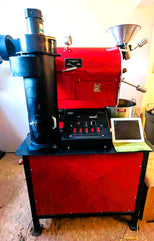
Air Roasting Coffee: What Is Air Roasting & Why It Matters
If you really want to spark debate among coffee roasters, just ask: “Air-roast or drum-roast, which is better?” The conversation has been going strong ever since coffee industry innovator Michael Sivetz introduced the first commercial air roaster in the 1970s.
While drum roasting has been the traditional method for centuries, air roasting (also known as fluid-bed roasting) shook up the coffee world by using hot air instead of a heated surface. That innovation sparked nearly 50 years of discussion, and it’s only grown louder as specialty coffee has entered the mainstream.
Today, both home brewers and professional roasters are rethinking what roasting style delivers the best cup. The truth? There’s no one-size-fits-all answer, because taste is deeply subjective.
As roastery professionals, we value both methods. Still, air roasting has unique benefits worth exploring, and we’re excited to share why it might be the right fit for your cafe or roasting business.
What Is Air Roasting?
Air roasting, also called fluid bed coffee roaster process, is a roasting coffee method that uses a stream of hot air to roast beans. It does not rely on direct contact with a heated drum. The beans are suspended and circulated in the air stream, creating a consistent roast.
Unlike traditional drum roasting, where beans sit against a hot surface, air roasting eliminates the risk of scorching or uneven heating. This method lets roasters highlight the natural flavors of the coffee, often producing a brighter cup. It’s a process rooted in precision. Also, it offers greater control over temperature and airflow.
Air roasters are also typically smaller, more efficient, and easier to operate than their drum counterparts. They are attractive for modern cafes and roasteries. For those seeking consistency, clarity of flavor, and streamlined roasting, air roasting offers a compelling alternative to tradition.
How Does Air Roasting Work?
Air roasting is a modern approach to coffee roasting that trades the traditional hot metal drum for a stream of circulating hot air. Air suspension of the beans results in a consistent roast and distinct flavor clarity. To better understand it, let’s walk through the steps of how air roasting actually works.

Step 1: Hot Air Flow Begins
The process starts with the air roaster generating a powerful stream of heated air. This airflow is directed into a chamber designed to hold coffee beans in constant motion. Instead of heating the beans through surface contact, the hot air itself becomes the roasting medium.
Step 2: Beans Begin to Levitate
As green coffee beans are introduced into the chamber, the airflow lifts them off the bottom. Then it creates what’s known as a “fluid bed.” This levitation ensures the beans are in constant rotation. Also, it prevents any chance of scorching or uneven roasting.
Step 3: Even Heat Distribution
Perfectly controlled hot air circulates through the beans, roasting each bean evenly.
heating and moving a coffee batch in a heated air stream. It results in a consistent roast where the full natural character of the bean can shine through. Many roasters find that this produces brighter flavors and a cleaner cup compared to drum roasting.
Step 4: Chaff Separation
During roasting, beans naturally shed their outer skin, called chaff. In drum roasting, chaff can linger and sometimes burn, creating smoky flavors. With air roasting, the airflow naturally lifts the chaff away and collects it separately. So, it reduces unwanted bitterness or aftertaste.
Step 5: Cooling & Finishing
When the beans reach the desired roast level, cool air rapidly replaces hot air in the chamber. Its immediate cooling halts the roasting process, locking in the flavors and aromas for a fresh profile.
6 Reasons to Consider Air-Roasting
When it comes to coffee roasting, tradition has long favored the drum roaster. But in recent decades, air roasting has emerged as a serious contender for both professional roasteries and home enthusiasts.
A stream of hot air roasts the beans without direct surface contact. So, it offers benefits that improve flavor, efficiency, and even your bottom line. If you’re exploring whether air roasting could be the right choice for your business, here are five compelling reasons to consider it.
Short Roasting Time = High Productivity

Air roasters can cut roasting time in half compared to traditional drum roasters. A typical batch of green coffee beans takes only 6 to 8 minutes, whereas drum roasting often requires 12 to 15 minutes.
This shorter roasting cycle does more than just speed up production:
Preserves Flavor: Less time in the air coffee roaster reduces the development of harsh acidic compounds that can cause bitterness.
Gentler on the Stomach: Many coffee drinkers report that air-roasted beans produce a smoother cup that’s easier to digest.
Boosts Output: With shorter cycles, you can roast more batches in a single day. So, it maximizes the efficiency.
For roasteries focused on consistent output and a clean flavor profile, the time savings are a major advantage.
Clean Roast, Clean Flavor

Air roasting operates much like a popcorn popper, with hot air circulating the beans to keep them moving and evenly exposed to heat. This airflow not only ensures consistency, but it also actively removes chaff. The thin outer skin is shed during roasting.
By separating the chaff and other light debris from the beans:
Only the beans themselves are roasted. So, it reduces the chance of burnt or smoky undertones.
The final cup is often described as cleaner, smoother, and fresher.
The process minimizes carcinogenic compounds that can occur when chaff burns inside a drum roaster.
The result is a product that highlights the natural character of the bean rather than masking it with unwanted flavors.
Consistency You Can Count On

One of the standout advantages of air roasting is its precision and repeatability. Most modern air roasters use a thermocouple to digitally measure bean temperature in real time. With this data, roasters can fine-tune heat and airflow adjustments to maintain exact control over the roast profile.
This level of accuracy offers several benefits:
Ability to replicate roast profiles batch after batch.
Flexibility to offer different roast degrees with confidence.
More even appearance, as beans tend to “puff” slightly and develop a uniform surface.
For roasteries, reproducibility isn’t just convenient, it’s essential for building a reliable brand. Customers expect consistency, and air roasting gives you the tools to deliver it every time.
Accessible and Cost-Effective

Air roasters are generally more affordable than drum roasters. It makes them a popular entry point for small businesses or cafes looking to start roasting in-house. While they usually have smaller batch sizes, they still deliver impressive productivity over the course of a workday.
Here are some examples of output:
Sonofresco 1 kilo/2 lb roaster: Up to 55 pounds of roasted coffee in 8 hours (about 6 to 7 lbs/hour).
Coffee Crafters 3e Roaster: Up to 144 pounds in 8 hours (18 lbs/hour).
Coffee Crafters Valenta 8: Up to 64 pounds in 8 hours (8 lbs/hour).
For the investment, these machines can produce enough coffee to serve a small-to-medium customer base. All can be done without the upfront cost or footprint of larger drum roasters.
Easy Setup, Smaller Footprint

Unlike drum roasters, which often require gas lines, ventilation systems, and permits, air roasters are largely plug-and-play machines. With standard installation tools, you can set one up quickly and get roasting almost immediately.
Additional advantages include:
No extra equipment needed: No afterburners, exhaust systems, or external chaff collectors.
Eco-friendly operation: Reduced smoke and particulate output means a lower environmental footprint.
Flexible placement: Their smaller size and no need for venting grant installation in a variety of spaces.
This simplicity makes air roasting especially attractive for cafes or small roasteries. Especially those who want to offer in-house roasted coffee without the hassle of large-scale infrastructure.
Suitability for Home and Commercial Use
Air-roasters are versatile, making them ideal for both home enthusiasts and commercial settings. They allow precise temperature control, consistent results, and small or large batch roasting, ensuring quality coffee for personal enjoyment or business needs.
Air Roasting Vs Drum Roasting
Both air roasting and drum roasting have loyal fans, and for good reason. Each method brings unique strengths to the table. The “better” option often comes down to the needs of the roaster and the preferences of the drinker. Here’s a side-by-side look at how they compare:
| Feature | Air Roasting (Fluid-Bed) | Drum Roasting (Traditional) |
|---|---|---|
| Heat Source | Hot air circulation | Heated drum surface with airflow |
| Roast Time | 6-8 minutes (faster) | 12-15 minutes (slower) |
| Flavor Profile | Clean, bright, smooth | Rich, complex, layered |
| Consistency | High reproducibility with digital controls | Depends heavily on roaster skill & adjustments |
| Chaff Removal | Automatic separation during roasting | Often burns inside the drum, can affect flavor |
| Cost & Accessibility | Generally more affordable, smaller capacity | Higher cost, larger capacity |
| Setup Requirements | Plug-and-play, minimal venting | Requires gas lines, ventilation, and permits |
| Aesthetic Appeal | Compact, modern, efficient | Large, traditional, visually impressive |
Flavor Experience
Air roasting often highlights the bean’s natural clarity, resulting in a cup that tastes smooth and bright. Drum roasting, on the other hand, creates complex flavors. Sometimes with a smoky or caramelized edge.
Consistency and Control
Air roasters rely on precise digital temperature readings. So, it is easier to replicate results. Drum roasters require more manual adjustments. It offers flexibility but also relies heavily on the roaster’s skill and attention.
Practical Considerations
For newcomers or small roasteries, air roasters are cost-effective, easy to install, and environmentally friendly. Drum roasters, while more demanding in terms of setup and cost, can handle larger volumes. Also, drum roasters offer a sense of tradition that appeals to many.

Final Thoughts on Air Roasting
At the end of the day, both air roasting and drum roasting can produce excellent coffee. What matters most is the dedication, precision, and passion of the air roaster for coffee behind the machine.
Air roasting, however, brings unique advantages to today’s coffee landscape. Their faster roasting times, clean and consistent results, and equipment that is often more affordable and accessible. These benefits are why many believe air roasting represents the future of commercial coffee roasting.
No matter which method you choose, you should remember this: great coffee starts with high-quality green beans and a roaster who respects both the art and science of the craft. Let the tools support your work, but let your senses guide the overall process.
FAQs
Is air-roasted coffee healthier than drum-roasted coffee?+
Air roasting naturally removes chaff during the process. It greatly reduces the chance of burnt residues and potential carcinogens. Many coffee drinkers also find it gentler on the stomach, though both methods are safe when done properly.
Does air roasting make coffee taste better?+
Taste is subjective, but air roasting often produces a smooth cup that highlights the bean’s natural character. Drum roasting, by contrast, can improve complexity and body. Ultimately, “better” depends on your preference for flavor clarity versus richness.
Are air roasters more affordable than drum roasters?+
Yes, air roasters typically cost less upfront and require less infrastructure. So, they can be a great entry point for small businesses. However, they often have smaller batch capacities compared to larger drum roasters.
Can I use an air roaster for commercial coffee production?+
Absolutely. Many modern air roasters, like models fromCoffee CraftersorSonofresco, can produce over 100 pounds of coffee in a workday. They’re especially practical for small to medium roasteries or cafes wanting in-house roasting.


Leave a comment